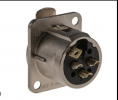Davide
Senior Member
Hi everyone.
I'm modifying the case of my amplifiers to make it more compliant with safety and signal integrity requirements.
However, a doubt has arisen that I can't dispel (I'm not a great connoisseur of electronics).
Bruno Putzeys wrote a paper for Hypex about the famous ground.
The summary for the interconnections is practically the following:

Now. It's not clear to me where those two points I circled in yellow should be connected. I'm guessing at the case, somewhere away from where the screen was connected.
But looking at the pinout of the Hypex NCxxxMP modules, does it mean that it is the GND pin that has to go there?

Because if so, then I don't understand why some amplifier on the market hasn't such a connection (seeing photos here and there).
Worse, some seem not to even connect pin 1 to the chassis. Look at Audiophonics.

The three xlr conductors go to the board, therefore assuming that pin 1 (shield) is connected to the GND pin of the amplifier. Which is the common mistake Bruno talks about in the document. Calling GND the pin 1 leads to this error. In reality the differential signal does not need to conduct the ground, the signal is the potential difference between hot and cold, there are no other references.
Can anyone help me clarify?
I'm modifying the case of my amplifiers to make it more compliant with safety and signal integrity requirements.
However, a doubt has arisen that I can't dispel (I'm not a great connoisseur of electronics).
Bruno Putzeys wrote a paper for Hypex about the famous ground.
The summary for the interconnections is practically the following:
Now. It's not clear to me where those two points I circled in yellow should be connected. I'm guessing at the case, somewhere away from where the screen was connected.
But looking at the pinout of the Hypex NCxxxMP modules, does it mean that it is the GND pin that has to go there?
Because if so, then I don't understand why some amplifier on the market hasn't such a connection (seeing photos here and there).
Worse, some seem not to even connect pin 1 to the chassis. Look at Audiophonics.
The three xlr conductors go to the board, therefore assuming that pin 1 (shield) is connected to the GND pin of the amplifier. Which is the common mistake Bruno talks about in the document. Calling GND the pin 1 leads to this error. In reality the differential signal does not need to conduct the ground, the signal is the potential difference between hot and cold, there are no other references.
Can anyone help me clarify?
Last edited:

